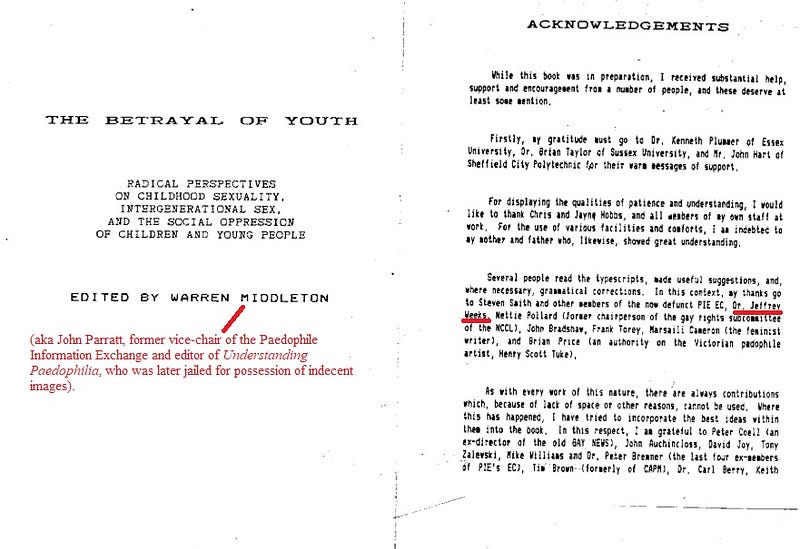Pat Califia, a ‘titan’ of Queer Theory, consistently advocated for the legalisation and normalisation of paedophilia. Dr Em was banned from Medium. We rehost her works here.
Part I is available here: https://uncommongroundmedia.com/the-trojan-unicorn-queer-theory-and-paedophilia-part-i-%ef%bb%bf-dr-em/
Part II is available here: https://uncommongroundmedia.com/the-trojan-unicorn-qt-and-paedophilia-part-ii-dr-em/
Califia
Califia described Public Sex as representing ‘the bulk of my nonfiction work from 1979 to the present. That’s a decade and a half of fuming and fussing about sexual repression and censorship, bragging about my search for an ever more forbidden way to have an orgasm’.1 Sounds exciting, however, it is early on in the text when Califia introduces the ideas of a ‘transgendered lesbian’ (a lesbian with a penis) and ‘cross generational sex’- also known as paedophilia.2 Califia then quotes Jonathan Katz, a queer academic and activist, and Jeffery Weeks, and normalises paedophilia claiming that their works ‘were especially helpful and informative’.3 To make it clear who Califia was learning from, here is Weeks being acknowledged by the former vice-chair of P.I.E. Warren Middleton in a pro-paedophilia text:

In ‘No Minor Issues: Age of Consent, Child Pornography, and Cross-generational Relationships’ written in 2000 Califia admits that she/he thought that all age of consent laws should be repealed.4 Califia then details the availability of child abuse imagery and bemoans ‘the 1977 passage of federal laws against [child abuse imagery]’ which would have ‘garunteed that it would disappear from the shelves of adult book shelves’.5 Who is saddened that child sexual abuse imagery would be harder to access? Califia expressed dismay that ‘antiporn feminists and antigay cops and politicians continued to speak about the growing menace of child pornography’.6 Those awful anti-porn feminists campaigning against child sexual abuse, how devilish. Califia then attempted to present objections to paedophilia as a form of homophobia and complained that ‘in the late ’70s, child porn and statutory rape laws were disproportionately enforced against gay men who had sex with adolescent males [otherwise known as children]’. 7 If it sounds like you have heard this story before, remember we are currently watching feminists being attacked and labelled transphobic for supporting child safe-guarding. To return to the past, Califia celebrated that she/he ‘knew several gay men who proudly called themselves boy-lovers’, that she/he socially mixed with paedophiles and described child sexual abuse as ‘erotic initiation’.8 To repeat, this is one of the people considered a titan of queer theory. Significantly, Califia argued that ‘what the cops called “protecting children” looked like repression of queer youth’. These arguments are back as we see child safeguarding policies described as ‘transphobia’.9 As we see in current transgender debates, the goal posts were then shifted. On page 59 Califia compares teenagers having sex with each other to adults sexually abusing children. Califia compared opposition to teaching children and teenagers that paedophilia was an acceptable, if not potentially desirable, sexual experience to abstinence-only sex education pushed by the Christian right-wing. Surely there is a middle position? Feminists manage to argue for sex and relationship education without promoting paedophilia to children and teenagers. Queer theory is a philosophy of straw man arguments which all come round eventually to the child deciding to be abused.
Alongside, her/his pro-paedophilia arguments published in Public Sex throughout her/his career Califia consistently advocated for the legalisation and normalisation of paedophilia. Califia’s article ‘Feminism, Paedophilia, and Children’s Rights’, first published in the now banned paedophile magazine — Paidika — is currently hosted on a pro-paedophilia website.10 Califia was not only aware but excited that her/his work would be published in a European journal for paedophilia. Califia stated that this piece ‘will be translated into Dutch and published abroad in a special issue of Paidika on women and pedophilia’ and that ‘I support Paidika and enjoy working with the editors of this special issue’.11 There you go, Califia, considered a titan of queer theory, publicly stated that she/he supported paedophiles. At least Califia, unlike Rubin, admitted that most gay and lesbian people do not want to have anything to do with child sexual abuse in his/her declaration that she/he knew that she/he ‘probably could not get anything on this topic published today in the American gay and lesbian press’.12 Hurrah! Califia set the tone for the article from the off, explaining that ‘In 1980 I published a two-part article in The Advocate, critiquing American age-of-consent laws’ thus assisting an Overton window shift.13 When queer theory converges with legislation this seems reasonable. Commenting on part of the reason feminists abhor Califia, she/he lamented that ‘Doc and Fluff, my recent science-fiction novel, has been banned by some women’s bookstores because it supposedly depicts a cross-generational lesbian relationship, and I’ve been attacked as “an advocate of child molestation” in the feminist press’.14 Notice that term again ‘cross-generational’, what’s that I hear; alarm bells. Califia argued that ‘The American government’s campaign against the sexual rights of young people has been so successful that most gay men, lesbians, and feminists are convinced that the movement to repeal age-of-consent laws was nothing more than an attempt to guarantee rapacious adults the right to vulnerable child victims’.
15 Yes. Correct. However, most people and feminists understand the harms of child sexual abuse without being taught about it by the American government. Califia claimed that in its refusal to accept NAMBLA in its movement ‘The adult gay community here has cut off its next generation’.
16 Nope, it is protecting children from sexual abuse. Califia posited that ‘I know very few lesbians, and even fewer gay men, who waited until they were eighteen to come out’.17 Age of coming out shouldn’t open one up to sexual abuse. It is noteworthy that Califia doesn’t critique that gay and lesbians have to come out because heterosexual is culturally held as ‘normal’. Califia then argued that child sexual abuse is desired by the child claiming that ‘Most of us were aware well before puberty that we wanted to be close to or sexual with members of our own sex’.18 Califia griped that ‘most American gay-rights activists and lesbian-feminists display’ ‘suspicion and hatred’ ‘toward pedophilia’.19 Yes, tick, correct. Finally, a queer theorist has admitted that paedophilia is unwelcome in the rainbow.
Queer theorists such as Califia reframed feminism as a social purity movement due to feminism’s defence of women and girl’s boundaries.20 Califia asserted that the ‘feminist antiporn movement mirrored a growing conservatism in American society about all sexual matters. As economic conditions here got worse, people began to look toward “traditional values” to provide a feeling of security and safety’.
21 The connotations and connections Califia was drawing are clear. Califia lamented that her/his feminist critics have characterised her/him ‘as [a] pervert and advocate of rape, battery, and child abuse’.22 Well, if you don’t wish to be characterised as such don’t advocate it. Nevertheless, Califia as a proponent of queer theory will necessarily have to support the ‘queering’ of sexual boundaries as good in and of itself. Indeed, the two theories — feminism and queer — are totally opposed. Califia and queer theory was not only attacked by feminists but is so obviously morally bankrupt that even the enemies of feminism — conservatives — expressed similar sentiments. Califia responded to these critics that ‘The panic over child pornography and pedophilia that has racked American society since the ’70s is an inseparable part of our society’s denial of the shortcomings and failures of the family’. No I don’t get the link either, nor is her/his statement justified in the text. Califia’s argument that many children are murdered by their families does not explain why child pornography is not bad (hint, child pornography is bad and Califia is wrong). Califia then attempted to align pro-paedophilia and queer theory with genuinely progressive movements. Califia argued that ‘Moral crusades have also been used to attack both feminism and gay rights, and neither of these progressive movements has been very successful at defending itself against such attacks or at presenting a complete analysis of them’.23 Despite the previous condemnation of feminism and the admittance that advocating for child sexual abuse is unwelcome and unconnected with the gay and lesbian rights movement, queer theory, as propounded by Califia, continued to cloak itself under feminism and the rainbow.
Reminiscent of the radio broadcast of a conversation between Foucualt, Hocquenghem and Danet and in the work of Rubin, Califia argued for the legalisation and normalisation of child sexual abuse imagery. Califia complained that ‘Child pornography has been a special category in American law since 1977’ and argued that homophobia, particularly the legal campaign by Anita Bryant, is the reason that child sexual abuse imagery is banned.24 Once again a queer theorist linked gay rights with the right to sexually abuse children. It was and is an appalling argument to make. In the next section Califia tried to minimize the damage child sexual abuse causes by describing it as ‘kiddy porn’. Let us call it what it is — the rape and abuse of a child inflicting horrific pain. In one of the only sections of Califia’s work which I can discern any innovative arguments, Califia claimed that the Post Office was targeting gay people in a huge conspiracy.25 It is quite the read. According to Califia, the American government and feminists were not trying to remove the scourge of child abuse imagery but were rather endeavouring to enforce traditional values and social purity. This is a giant of queer theory: Califia in her/his various arguments suggested that feminists are in league with the Post Office in a grand homophobic conspiracy. Califia complained that
The Post Office targets people who are unlucky enough to have landed on mailing lists compiled by U.S. Customs. These lists come from many sources. When adult-porn businesses are raided, the authorities also confiscate their mailing lists… The Post Office and Customs keep track of people who order sexually explicit material through the mail. Police have even confiscated the membership list of a gay computer bulletin board that was shut down because its operator was accused of violating age-of-consent laws. The Post Office then conducts direct-mail campaigns soliciting orders for child porn… Law enforcement officials sometimes become pen pals, pretending to be pedophiles or sexually active children, and solicit their correspondents to send or receive child porn through the mail. If targeted individuals seize the bait, they are arrested’.26
Yes, Califia thinks that the arrest of paedophiles is the problem. Califia objected that ‘American society has become rabidly phobic about any sexual contact between adults and minors’.27 The use of the term ‘phobic’ is striking. This cast opposition to child sexual abuse as based on an irrational fear, with the problem being placed squarely with those who object. To reinforce this reframing of objections to child sexual abuse as hysterical, throughout the article and without signal Califia switched between talking about the sexual abuse of children and teenage sexual activity. This was a calculated attempt to obscure the argument that adults should be allowed to have sex with children. In another move of concealment Califia claimed that ‘Lesbian-feminism supposedly empowers women, but we are reluctant to see young women’s sexual experiences as anything but victimization’.28 Califia is arguing that young girls should be seen as agents in their own abuse and masking the fact that 98% of sexual abusers are male, and the majority are heterosexual.29 This is what queer theory does, it obfuscates victim and abuser, it renames abuse as agency, and when that cloaking doesn’t work it resorts to the notion originally espoused by Foucault that power exists through discourse and there is no reality outside the narrative. Queer theory is more smoke and mirrors than philosophy. Poof, abuse has disappeared.
As predictable as the sun will rise, Califia made the argument that opposing adults sexually abusing those under the age of consent is ageism. Califia contended that ‘We give lip service to confronting ageism, but we do not really include underage lesbian and bisexual women in our community’.30 Califia tried to muddle the matter yet again by obscuring the fact that 98% of people that sexually abuse children are male. Califia appealed to sentiment and argued that ‘adolescent dykes should experiment sexually and romantically with each other. But when they are trapped in schools, neighborhoods… where being called queer targets them for harassment and assault how many young lesbians can afford to come out or seek out others like themselves?’.31 Rather than target the culture of bullying and non-acceptance Califia targets age of consent laws and child protection. Go figure. After spending an entire article bemoaning state interference in the lives of citizens and child sexual activity Califia then makes a remarkable volte face. Califia proposed that ‘the state is not willing to take the radical action that would be necessary to protect child victims of abusive adults. That would mean challenging parents’ ownership of their children. It would mean providing viable alternatives to the family’.32 That statement is chilling, Califia is sick of parents safeguarding their children from sexual abuse and proposes a loss of custody. This sudden reversal regarding state intervention highlights the hollowness of queer theory and it’s shifting principles. Queer theory contorts and warps to advance men’s sexual rights by any argument necessary.
The online Paedophile collective have provided a hopeful after note. They report that ‘In Pat Califia’s 2nd Edition of Public Sex, The Culture of Radical Sex, she expresses a sad change in stance. As of 2000, she no longer accepts prepubescent children’s and many young teenager’s possibility to consent to erotic or sexual contacts with adults’. ‘She has become much more cynical about adults and their ability to listen to children, and now as a parent she thinks more in terms of making the child’s welfare a priority than of consent’. The phrase ‘making the child’s welfare a priority than of consent’, to me, suggests that Califia and the paedophile collective recognise the harm and that any ‘consent’ is coerced and illusionary. Nevertheless, queer theory’s influence has poisoned a wave of feminism. For example, Sarah Beresford’s inability to break free from queer theory led her to question whether age of consent laws were protectionist and ‘concede that the current law surrounding the age of consent not only denies the agency of girls and boys under the age of 16, but also places them in a position of non-autonomous passivity’.33 This underscores how destructive and hollow a philosophy queer theory is. Queer theory is the ultimate backlash against feminism.
Part IV:
http://uncommongroundmedia.com/the-trojan-unicorn-qt-and-paedophilia-part-iv-dr-em/
- P. Califia, Public Sex: The Culture of Radical Sex, 2nd Edition (San Francisco, Cleis Press, 2000), p. xii.
- ibid. pp. xvi — xvii.
-
ibid. p. xx. - P. Califia, Public Sex: The Culture of Radical Sex, 2nd Edition (San Francisco, Cleis Press, 2000), pp. 55–56.
- ibid. p. 56.
- ibid.
- ibid.
- ibid.
- ibid.
- P. Califia, ‘Feminism, Pedophilia, and Children’s Rights’, Paidika (1991), & in The Culture of Radical Sex (1994). https://www.ipce.info/ipceweb/Library/califa_feminism.htm [Accessed 30 March 2019].
- ibid.
- ibid
- P. Califia, ‘Feminism, Pedophilia, and Children’s Rights’, Paidika (1991), & in The Culture of Radical Sex (1994). https://www.ipce.info/ipceweb/Library/califa_feminism.htm [Accessed 30 March 2019].
- ibid.
- ibid.
- ibid.
- ibid.
- ibid.
- ibid.
- ibid.
- ibid.
- ibid.
- ibid.
- ibid.
- ibid.
- ibid.
- ibid.
- ibid.
- https://stopabusecampaign.org/2017/03/10/most-sex-abusers-are-heterosexual/
- ibid.
- ibid.
- ibid.
- S. Beresford, ‘The Age of Consent and the Ending of Queer Theory’, Laws (2014), 3, p. 769.







